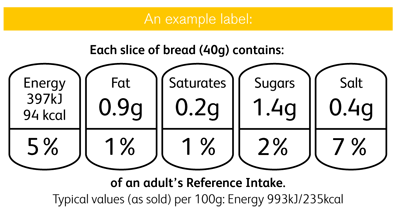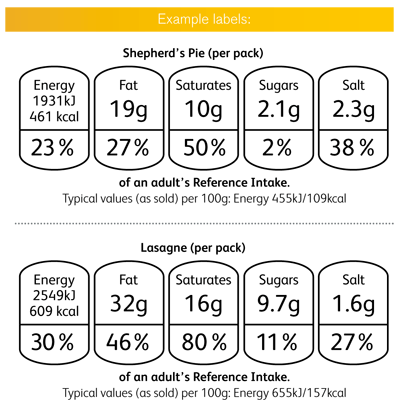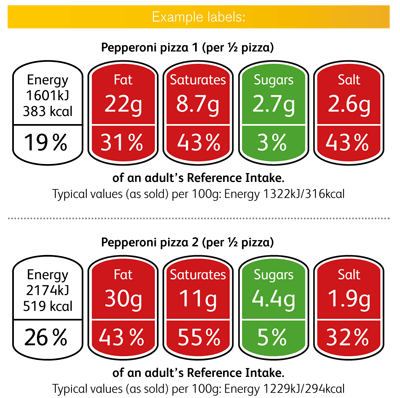Section 2: Front of pack labelling
Nutrition information on the front of pack
Although labels are changing, most packaged food and drink products will
continue to show simple nutrition information on the front of pack which is
provided
voluntarily by manufacturers.
Front of pack nutrition labels will show either:
Energy
or
Energy | Fat | Saturates | Sugars | Salt

All of this information will be provided in grams (g) apart from energy which
must now appear in 'kilojoules' (kJ) and 'kilocalories' (kcal).
This information will also normally be provided as a percentage of the Reference
Intake, the new term for Guideline Daily Amount.
Normally the nutrition information on a label will be given in a portion or
unit and this will be shown immediately next to the label e.g. 'per ½ of a
pizza'
or 'per slice'.
IMPORTANT: People often use 'calories' and 'energy' interchangeably. If you
advise a patient to watch their calorie intake, make sure that they understand
to
look for the number in the energy icon that is followed by kcal.
top
Using front of pack labels to check, compare and choose
The front of pack label allows patients to:
- Check what their food contains - how much energy and how many grams of fat,
saturates, sugars and salt plus how much of their Reference Intakes this
contributes to
- Compare foods they buy with other similar foods
- Choose the foods that best suit their needs
The label also allows people to:
- Keep an eye on portion size
- Focus on the nutrients that are important to them
- See how individual foods fit into a balanced diet

IMPORTANT: Encouraging patients to get into the habit of using the front of pack label to
check the content of foods on a regular basis will make them more conscious of
what they are eating.
top
Variations on front of pack labels
Now that the basic elements of a label on the front of pack are set down in
European law there is greater consistency in what shoppers will see on pack, no
matter what the individual brand or which supermarket someone shops in.
As well as the information already covered in the previous pages, some labels
will have a traffic light colour (red, amber and/or green) overlaid on top of
the
nutrition information, along with the Reference Intake information. The colour
coding is a UK-wide government scheme and provides an indication of whether
there
is a high, medium or low amount of the nutrient per 100 grams.

IMPORTANT: Sometimes products may have a similar colour code but still have different
nutrition information. The detailed RI information can help patients choose
between
products that have the same colour. See the example below which shows how the
RIs can help choose between two similar pizzas.
top